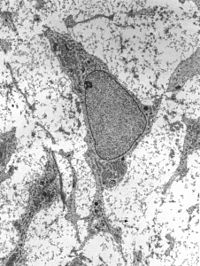
Photo from wikipedia
Cellular models of neurodevelopmental disorders provide a valuable experimental system to uncover disease mechanisms and novel therapeutic strategies. The ability of induced pluripotent stem cells (iPSCs) to generate diverse brain… Click to show full abstract
Cellular models of neurodevelopmental disorders provide a valuable experimental system to uncover disease mechanisms and novel therapeutic strategies. The ability of induced pluripotent stem cells (iPSCs) to generate diverse brain cell types offers great potential to model several neurodevelopmental disorders. Further patient-derived iPSCs have the unique genetic and molecular signature of the affected individuals, which allows researchers to address limitations of transgenic behavioural models, as well as generate hypothesis-driven models to study disorder-relevant phenotypes at a cellular level. In this article, we review the extant literature that has used iPSC-based modelling to understand the neuronal and glial contributions to neurodevelopmental disorders including autism spectrum disorder (ASD), Rett syndrome, bipolar disorder (BP), and schizophrenia. For instance, several molecular candidates have been shown to influence cellular phenotypes in three-dimensional iPSC-based models of ASD patients. Delays in differentiation of astrocytes and morphological changes of neurons are associated with Rett syndrome. In the case of bipolar disorders and schizophrenia, patient-derived models helped to identify cellular phenotypes associated with neuronal deficits (e.g., excitability) and mutation-specific abnormalities in oligodendrocytes (e.g., CSPG4). Further we provide a critical review of the current limitations of this field and provide methodological suggestions to enhance future modelling efforts of neurodevelopmental disorders. Future developments in experimental design and methodology of disease modelling represent an exciting new avenue relevant to neurodevelopmental disorders.
Journal Title: Molecular Psychiatry
Year Published: 2019
Link to full text (if available)
Share on Social Media: Sign Up to like & get
recommendations!